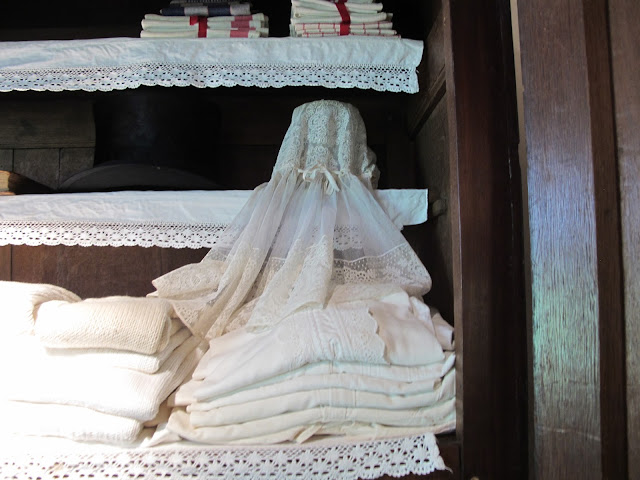The "Hagedoornse Plaatse" is a farm in Epe in the country, built in 1715 and is still maintained as it looked like in 1940. Since 2004 is opened as a museum and there are some small exhibitions in a special building next to the farm.
In this part of the country reed was used in the past to cover roofs and is still used for some farmhouses now.
Inside the farm you had a look how they lived, with a stove on which they also did the cooking.
They slept in a cupboard bed with closed doors and next to the stable with cows, which kept them warm in winter.
When the farmers' daughters became to old to sleep with their brothers in a cupboard bed, they got their own room.
I loved the huge linen cupboard, in the big drawers below they kept their clothes.
The bonnet is part of the regional costume.
When the farmer and his wife were too old to do the work, they lived in their own part of the farm until their death cared by their children who had taken over the farm.
The farm had their own vegetable garden which was kept by the farmers' wife.
In the exposition building was an exhibition about traditional underwear.
It was an interesting look in the past and we were said goodbye by this sheep.











This was so interesting! I had a roof like that when I lived there. But, I didn't know about the
BeantwoordenVerwijderensleeping cupboard! Hard working people.
Some aspects of this is similar to our Pioneer homes in the States but otherwise there is a lot of differences, like the cupboard bed. I had never heard of that before but could see how it would work in help to keep warm at night. Very interesting and thanks for showing it.
BeantwoordenVerwijderenThanks for the tour of this historical place. Interesting tiles in the kitchen area, too. So happy that communities reproduce places like this for visual and educational purposes!
BeantwoordenVerwijderenAlways so interesting to see how they survived in days gone by Marianne..It was a hard life but yet somehow it seems much less complicated than today don't you think?
BeantwoordenVerwijderenIk vind die oude tegeltjes erg mooi. En wat grappig die opstelling met ouderwets ondergoed.
BeantwoordenVerwijderenAn interesting tour. It is so good to see how our ancestors lived.
BeantwoordenVerwijderenIt's fascinating how people lived long ago. They had a technology that worked. I've never seen a bed in the cupboard or closet. When Mennonites first came here some of them had the barn and house attached.
BeantwoordenVerwijderenDearest Marianne,
BeantwoordenVerwijderenThat is quite impressive to have like a museum, kept the way it originally was. Pieter's Parents used to have a 17th Century home with a thatched roof as well. It got destroyed during the war, sadly. That thatching was quite an art and it was a thick layer for good insulation too.
Back than, beds were concealed in walls and resembled cupboards. At bedtime, one simply opened the ‘cupboard,’ crawled in, and shut the door of that alcove cupboard. Sometimes, potatoes were stored underneath.
At the Open Air Museum in Arnhem we also learned another fact of those days. Since people could not preserve meats other than in brining in salt, they mostly developed kidney problems from eating food too high in sodium. Sleeping almost in a seated, upright position was the consequence. If one does check the length of those alcove beds, it is a true fact. What a suffering back than and no wonder that the average age was not high.
Those antique armoires and linen cupboards do look impressive.
Thanks for sharing always such interesting posts with your readers!
Hugs,
Mariette
Yes, the guide mentioned they slept upright indeed, but she said it was because they were afraid to have a stroke. I think your version is more real. Those were hard times indeed to live in.
VerwijderenMarianne
Dearest Marianne,
BeantwoordenVerwijderenDid forget to mention that antique lace toer or poffer. I did once a post about it: http://bit.ly/160PsCj
Hugs,
Mariette
Those are much more beautiful, this one was simple for daily work, but there was another one with lace indeed, but too dark in that room to photograph.
VerwijderenLoved this post and the bit of history we got to see!
BeantwoordenVerwijderenThe ceramic walls are really special, it must have been very expensive in those days.
BeantwoordenVerwijderenGreetings,
Filip
Beds in cupboards was a common feature of crofts, the Scottish Highland version of a farm house. This is featured in the 1935 version of the thriller "The Thirty-Nine Steps". I love this post, very beautiful artifacts - almost worth leading such a hard life to experience using these things every day!
BeantwoordenVerwijderenCheers, Ruth